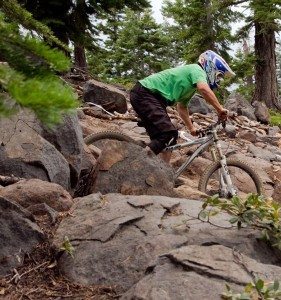The Good:
The BB height on my bike sits at 13.5”, right at the published number. It’s hard to convey just how hard you can slam a bike into squared off corners with your feet this low (especially on a preloaded 8” travel bike) if you’ve never done it. The 14.5” BB height standard wasn’t that long ago, and many bikes end up building at about that range or higher when real DH tires are put on anyway, regardless of what the manufacturers’ websites claim. That’s the world I came from, and I’m never going back.
Weagle claims the anti-squat design of these frames will help to actually keep your feet higher when pedaling than some 14-inch-plus frames that squat more under chain loads. I’ve got to say that I haven’t really had that experience from a noticeable “on the trail” standpoint with the bikes I’ve owned and the way I’ve had them setup.
The DHR is lower than most others out there, pedaling or not. And it’s friggin awesome. In what amounts to almost two full seasons now on this bike, I haven’t broken or ripped out a single pedal, bent a single crank, or cracked a single bashguard. Sure, I’ve knocked the crap out of all of those bits, but I’ve done that on every DH frame I’ve ever ridden. The big difference now is that I’m on a much more stable bike, and reaching mach stupid everywhere else is much easier and worth just paying attention to where you pedal. The best part is, I’ve found myself going faster into so many sections I’ve ridden for years, I don’t need to pedal to get up to the speed I want to be at. Sitting more between the wheels provides a more stable connection with the bike in chop, in the air, in corners…everywhere. It’s just the way it is. My 170mm cranks from my last frame are staying on this thing, and I’ve had no reason to go shorter.
Coming from an 08/09 round tube DHR, I noticed in the very first turn just how much stiffer these new frames are. The round tube DHRs weren’t exactly the stiffest frames around, but they weren’t total noodles, either. Without going into a lab and bending a bunch of frames with some deflection testing gear, I’d say these new ones are among the stiffest. The ability to hold lines on rough, off-camber traverses and sliding Dukes of Hazard corners is excellent. And the occasional sideways landing off a “stuck” moto whip doesn’t leave you bouncing around for the next 60 feet. It hurts once, straightens out, and gives you the ankle punishment you deserve for screwing the jump up and looking like a hack.
Pedaling on this bike just works. The frame stays level, the juice goes to the drivetrain, and if you need to crank in a rough spot, there’s not so much resistance to suspension compression that you’ll get bounced. The DW-Link bikes are renowned for this, and this one is no different. Again, I think some other designs will ride more “plush,” but when I’m on the pedals, it’s because I want to go faster, and I like that there’s more of a consistent transfer on a solid chainline and geometry.
Something worth noting is that the difference I’ve seen between the stock RC4 with zero HS compression damping and minimal LS compression damping, and the Rockshox Vivid air I have on there now is significant. I do get some pedal bob with the Vivid. It’s not much and it’s not noticeable on the trail, but I can see it pedaling up to the lift in the parking lot.

I’ve spent a lot of time dialing in proper sag on the Vivid and screwed around with the entire range of compression damping on that shock. It’s my belief that this has more to do with the compression capabilities of each damper more than anything. The Vivid air is just more ‘loose’ overall, even with the LS compression damping maxed out.


I LIVE IN TENERIFE, A HILLY PLACE.I LIKE TO PEDAL UP TO COME DOWN. I WANT TO BUY A TURNER DHR FRAME, I WONDER IF I COULD INSTALL A TWO RINGS CRANKSET, TO MAKE THE TURNER DHR MORE SUITABLE TO PEDAL UP ? I WOULD LIKE SOME ADVICES, THANKS
I’m not sure the DHR is really what you’d want for any kind of pedaling uphill Hugo. I’ve done it before with mine but just up some fairly mellow dirt roads. I mean it is a downhill bike. Maybe something like a Transition TR250 or a specialized enduro evo would be better.
Hi there
Can you post your settings on your boxxer world cup? How much sag and other thing.
I sold the Boxxer last year so I can’t check precise setting unfortunately. At 165lbs riding weight, I think I was running around 80psi for pressure with the bottom out volume reducer pretty much maxxed out. Those forks felt so spikey to me that I ran very minimal compression damping. I think just a few clicks in a low speed compression damping and literally no high speed damping.
That’s just on memory, sorry I couldn’t be more specific.